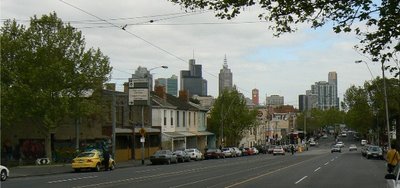 Here's a view of my soon to be neighborhood; those are tram tracks down the middle of the road. The house I'll be in is the first on the left. You can't see much of it, but it stretches from the left of the picture to that first mustard-colored railing; my room will be the one behind the railing.
Here's a view of my soon to be neighborhood; those are tram tracks down the middle of the road. The house I'll be in is the first on the left. You can't see much of it, but it stretches from the left of the picture to that first mustard-colored railing; my room will be the one behind the railing.But the big event in Melbourne today was the grand final of the Australian rules football season, which over 97,000 spectators watched the West Coast Eagles win by a single point, 85-84, against the Sydney Swans. Australian rules football started here in Victoria in the 1850s, and this is the first time in a long time no Melbourne team's been in the final, but everyone assured me "the Swans used to be South Melbourne" so they were the ones to root for. (Could you imagine Brooklynites rooting for the Dodgers in a playoff?) The Eagles, from faraway Indian Ocean-facing Perth, are strangers by comparison, but "West Coast" called out to me.
 Now sport, as you may know, is not my thing. In fact, when a religious studies scholar I was talking to yesterday confirmed the commonplace that sport is the Australian religion by saying "and tomorrow's grand final is Christmas," I decided to do what non-Christians often do on Christmas: I went to the movies. (For my sins, the film showing in ACMI's Great Australian Cinema series was "Crocodile Dundee," clichéd outback meets clichéd 1980s New York City!) Happily the film (which I was the only person watching!) ended in time for me to catch the second half of the game, broadcast on a big screen at Fed Square.
Now sport, as you may know, is not my thing. In fact, when a religious studies scholar I was talking to yesterday confirmed the commonplace that sport is the Australian religion by saying "and tomorrow's grand final is Christmas," I decided to do what non-Christians often do on Christmas: I went to the movies. (For my sins, the film showing in ACMI's Great Australian Cinema series was "Crocodile Dundee," clichéd outback meets clichéd 1980s New York City!) Happily the film (which I was the only person watching!) ended in time for me to catch the second half of the game, broadcast on a big screen at Fed Square.Footie's a mystery to me - it plays in a huge oval field with virtually no markings, and at times resembles soccer, rugby, basketball, American football, a brawl and (some say) a ballet. There was a lot of fumbling and lots of pileups, and the oval-shaped ball changed hands and side constantly. I could tell when something went wrong or something went right from the reactions of people around me, but I really had no idea what was going on. (Like looking up at a skyful of stars and seeing nothing you know, and yet they're stars, and yet there's no Big Dipper...) But exciting it was, the Swans coming from being behind over 20 points to within reach of winning - but never gaining the final edge.
And to explain the picture on the last post, it's from a children's book from 1918 called The Magic Pudding, and the magic pudding is also who/what Bunyip Bluegum the koala is holding in his hand. But more about that some other time.






















